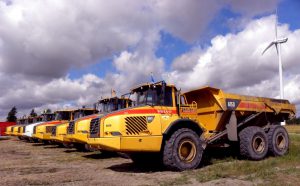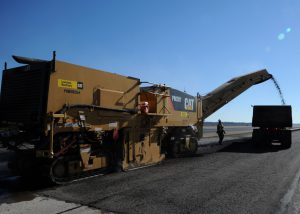What they are, how do they work and what are they used for?

I am pretty sure most of us have driven past a construction site and wondered what the various machines are used for. Some are humongous!
Those are the ones that require those traffic-slowing “abnormal loads” that we pass now and then on the highway. I always look at the machines being transported, and try to imagine what they do.
To solve a bit of the mystery for some of us, I have gone on a research mission to determine the names and uses of five construction machines that I think could be of interest.
Articulated Haulers

This type of machine is also known as an articulated dump truck (ADT), and is capable of traversing tough terrain.
These dump trucks are used for the removal of earth or construction rubble, among other types of materials, and have also been effective for snow removal. In an extreme situation, Linco Construction in Texas used their articulated haulers to evacuate victims of a Hurricane
Dragline Excavators

Dragline excavators are often used in road and underwater excavation, and in surface mining.
The heavier types of dragline excavators usually have to be assembled on site. These machines use a bucket and rope system to gather materials and dump them.
Sheepsfoot Rollers

The purpose of a sheepsfoot roller, which is also known as a tamping roller or padfoot roller, is used for soil compaction.
A typical sheepsfoot roller is made up of a drum with stud-like protrusions covering the surface of the drum. These studs can be manufactured in different sizes, depending on the type of soil that is to be compacted.
Cold planers

Cold planers are used to remove the surface of paved areas – a process known as milling. These milling machines grind the surface of, for example, a road (asphalt), in order to lay new asphalt, or to smooth out the road surface.
Milling allows for the road surface to be recycled, making it a positive factor in ongoing efforts to curb negative impacts on the environment.
Cold planers use a milling drum to cut the paved surface. Tool holders, which are attached around the drum, hold cutting tools which cut the pavement.
The milled materials are held in the machine’s scrapper, and then transferred from the cold planer, using a conveyor belt, to another vehicle to be transported from the site.
Tower Cranes

Cranes are often the first construction machines that we see, even when the site is not in plain sight – see what I did there 😉 These are very tall machines, which are used to lift various types of materials, in order to place them where they are required.
A typical tower crane consists of a base, mast, slewing unit, machinery arm, counter weights and an operator’s cab. The base of the crane is secured to a concrete pad, which provides support. The tower section (or mast) gives the crane height, and is connected to the base. The slewing unit houses the motor which allows the crane to rotate, and also includes a working arm (longer horizontal section), machinery arm (shorter horizontal section) and counter weights. The crane operator manoeuvres the crane from the operator’s cab.
During my research into this topic, I have enjoyed learning more about some of the machines that I have seen, but knew nothing about.
I do hope that next time you pass a construction site, and you see some of the machines that I have mentioned, that you will have a better understanding of their purpose.
Sources:
Babcock
Google
Wikipedia
Engineering Intro
If you are interested in becoming one of our subscribers, please visit our website.
To view notes with screenshots on how to use our website, please visit our Wiki site.
To view more articles, please visit our blog.
About Bianca Warwick
I had the privilege of joining the Leads 2 Business content team in January 2012. I work in the exciting Projects department, following the progress of construction developments in KwaZulu-Natal and the Free State.








Leave a Reply